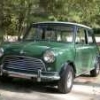
Cam Timing
#1

Posted 22 May 2011 - 08:45 PM
i want to put a 286 cam in my 1275 a plus but was told i would need an offset timing keyway? could anyone shed some light on this and as to
what keyway i would need or how to find out? would appreciate any info. thanks
#2

Posted 22 May 2011 - 09:52 PM
I prefer to use duplex vernier adjustable stuff as the cam timing can be set very acurately.
Have you done any other work to this 1275 engine? the cam wont work at its best if the head has not been worked on.
#3

Posted 22 May 2011 - 10:29 PM
With regard to timing, the ideal timing for a 286 is 106 degrees ATDC on inlets. To achieve this accurately you need to use either an offset woodruff key or a vernier cam drive sprocket. You measure using a DTI and crank protractor to measure the basic setting without any adjustment, then fit the offset key or rotate the vernier sprocket to remove any error. You may have to mneasure and re-set several times to get it absolutely right which is essential in a race engine. Of course, you can simply set the cam using the standard dot-to-dot method and it will run, but if fitting a 286 you won't get best power and it could run even worse at low revs that it will do when timed in accurately.
The 286 is a really lumpy cam and as you will be using lots of revs all the time to keep it on-the-cam expect to rebuild the engine more often.
#4

Posted 24 May 2011 - 08:41 PM
and have a mildly moded head vizard style. im hoping it will work well if i spend time setting it up properly.
#5

Posted 25 May 2011 - 12:32 PM
You have three choices. The cheapest is to use stock timing pulleys and line them up using the dot-to-dot method described in the manual. This however will not set your cam to the grinder's specified optimum angle. To set this angle accurately you use EITHER an offset key with standard timing pulleys, OR you use the vernier adjustable timing pulleys. You do not choose the offset key based on the cam maker's specs, you choose the key based on careful measurements. Setting the cam angle using any method other than dot-to-dot dictates that you MUST have a dial indicator and degree wheel.
There have been several threads here (with external links to tech articles) that describe how to degree a cam. Please try the search feature to find a few of these threads and read up on the process. If you can't find those old threads, post back and we'll help locate a few.
Regardless, the method of setting the cam angle is to measure the cam angle as installed before any adjustments/corrections are made (requires dial indicator and degree wheel) then determine how many degrees out the cam is from ideal. Knowing the angular error, you select an offset key to provide the correction OR you use the vernier pulleys to create the correction. Most people make an additional 1-2 degree offset to the cam timing to compensate for timing chain stretch that will occur during the break in period of the new timing chain.
#6

Posted 25 May 2011 - 12:45 PM
#7

Posted 25 May 2011 - 01:00 PM
if they KNOW it's always best at 106 degrees - why don't they grind the cam so it will install at 106 degrees!!??
The cam will be as accurate as they can make it and close to correct when dot-to-dot is followed with new, ideal components. However, the answer to your question is "tolerances".
There are MANY components that add into the tolerance stack up. You have the crank and its keyway (1 angular position), the keyways in both timing pulleys (2 angular tolerances), the pitch of the timing chain (God knows how you factor that in... one tolerance per link or....). Though I have not personally seen the dot-to-dot method off by more than a few degrees, I have seen one or two people post that they have found the dot-to-dot method out by as much as 6 degrees.
Setting the cam angle factors out ALL of these manufacturing tolerances to create the optimum lift when/where bench testing has shown the cam to perform best in testing.
#8

Posted 25 May 2011 - 04:12 PM
Oh and sorry to the OP if my previous post was in any way missleading. Of course you would use either the vernier gear or the offset keys. Not both..
#9

Posted 25 May 2011 - 07:56 PM
Maybe I'm overly fussy, but I time every cam in accurately on every engine I build at 2 degreees advanced from manufacturer's recommendation to allow for the high initial chain stretch which settles down after a few thousand miles.
It's not really an onerous job and when it is absolutely accurate it's very satisfying to have done the job right. I do believe it makes for a better engine. Time taken can be anything from 10 minutes to an hour. Just start with the baqsic standard dot-to-dot and measure that. The correct with offset key as necessary.
#10

Posted 26 May 2011 - 12:17 PM
I set my cam RE 13 OT at 104 deg based on what the manufacturer said was the optimum.
So have I got this wrong then mr dklawson.
should I not have set it to the makers suggested settings.
You have done nothing wrong. Roy mentioned the 106 degrees.... I never mentioned the specific angle because it can be different for different cam grinds.
All I suggested is what Cooperman said, a 1-2 degree increase in the cam angle (initially) so the cam will drift into "proper" time as the timing chain stretches. The spec provided by the manufacturer will not include that extra 1-2 degrees.
1 user(s) are reading this topic
0 members, 1 guests, 0 anonymous users
















